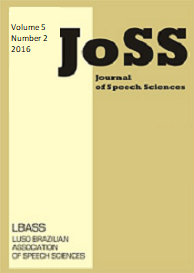Abstract
Hierarchical or indirect recursion can be found in different domains of human language and thus, it has been claimed to be the only part of language that is specific to humans (Hauser, Chomsky, and Fitch 2002). However, in the past decade, both the claims that, recursion is the central component of the “narrow faculty of language” and that, it should be present in all languages have been the object of intense debate (cf. Pinker & Jackendoff, 2005; Everett, 2005). This debate triggered the exploration of new frontiers in the examination of embedded structures, which have been examined in acquisition and in processing and have been shown to be implemented through a wide array of linguistic resources in different languages. This paper presents an acoustic description and a neuro-psycholinguistic analysis (ERP/EEG) of an uncommon cognitive device to embed relative clauses. It is implemented in Karajá, a Macro-Je language spoken in Central Brazil, which uses pitch accent to signal relativization: (i) [tori do‟rode] „the white man arrived‟ versus (ii) [tori doro‟de] „the white man who arrived‟, first described in Ribeiro as stress shift (2006). The major interest in studying this phenomenon is because in Karajá, more than structuring envelopes for acts of speech, prosody codes directly onto the central syntactic algorithm of recursion. We found evidence in favor of a stronger facilitation to process a coordinated structure than a recursive structure. We found smaller RTs and amplitudes in the EEG related to the coordinated conditions versus the embedding conditions. Also, it seems that even though embedding is harder to launch, hierarchical structuring makes it easier to process in the third embedding, when comprehenders learn they are in an embedding mode. Coordination, on the other hand, being a default, is easier to launch, but it seems to become progressively harder as it does not benefit from hierarchical structuring.
References
Barbosa PA. From syntax to acoustic duration: A dynamical model of speech rhythm production. Speech Communication, 2007.
Bear M, Conners B, Paradiso M. Neuroscience: Exploring the Brain. 3rd. ed. Philadelphia: Lippincott, Williams and Wikins, 2006.
Boersma P, Weenink D. Praat: doing phonetics by computer (version 6.0.2)[computer program]. Retrieved September 3, 2016.
Brown C, Hagoort P. The processing nature of the N400: Evidence from masked priming. Journal of Cognitive Neuroscience, 1993.
Campbell N. Automatic detection of prosodic boundaries in speech. Speech Communication, 1993.
Chomsky N. Syntactic Structures. The Hague: Mouton; 1957.
Chomsky Noam. Three Factors in Language Design. Linguistic Inquiry, 2005.
Crawley Michael J. The R book, second edition. Chichester: John Wiley, 2013.
Everett D. Cultural constraints on grammar and cognition in Piraha: Another look at the Design Features of human language. Current Anthropology 2005.
França AI, Lemle M, Gesualdi A. da R, Cagy M, & Infantosi A F C. A neurofisiologia do acesso lexical: palavras em português. Revista Veredas, 2008.
Gendrot C, Adda-Decker M. Impact of duration on F1/F2 formant values of oral vowels: an automatic analysis of large broadcast news corpora in French and German. Proceedings of the 9th European Conference on Speech Communication and Technology (Interspeech), 2005.
Gomes J N, França A I. A direcionalidade no relacionamento semântico. Revista Veredas, 2008.
Gomes J N, França A. I. The ample semantic scope of minute language computations: an ERP study of words in Portuguese. Revista da Anpoll, 2013.
Hauser M, Chomsky N, Fitch WT. The Language Faculty: What is it, who has it, and how did it evolve? Science 2002.
Kutas M, Hillyard S. Reading Senseless Sentences: Brain Potentials Reflect Semantic Incongruity. Science, 1980.
Kutas M, Hillyard S. Brain potentials during reading reflect word expectancy and semantic association. Nature, 1984.
Ladd D R. A practical introduction to stress, accent, and tone. Course given at the summer school of ABRALIN 2017.
Lau E F, Phillips C, Poeppel D. A cortical network for semantics: (de)constructing the N400. Nature reviews. Neuroscience, 2008.
Liénard J S, Barras C. Fine-grain voice strength estimation from vowel spectral cues. Proceedings of the 14th Annual Conference of the International Speech Communication Association (Interspeech), 2013.
Lourenço-Gomes M C. Maia M, MORAES João A. Prosódia Implícita na Leitura Silenciosa: Um Estudo com Orações Relativas Estruturalmente Ambíguas. In: Marcus Maia; Ingrid Finger. (Org.). Processamento da Linguagem. Pelotas: Educat, 2005.
Maia M. The structure of CP in Karajá. In: Camacho, José; Gutiérrez-Bravo, Rodrigo; Sánchez, Liliana. (Org.). Information Structure in Indigenous Languages of the Americas: Syntactic Approaches. : Mouton De Gruyter, 2010.
Maia M. A computational efficiency principle in action in the processing of recursively embedded PPs in Brazilian Portuguese and in Karajá. Gragoatá, 2016.
Maia M, França A I, Gesualdi A, Lage A C, Oliveira C, Soto M, Gomes J N (to appear). The processing of PP embedding and coordination in Karajo and in Brazilian Portuguese. In: L.Amaral, M. Maia, A. Nevins, T. Roeper. Recursion across domains. Cambridge University Press.
Perez-Leroux A T, Castilla-Earls A P, Bejar S, Massam D. (to appear). Strong continuity and children‟s development of DP recursion. In: Recursion Across Domains and Latitudes, eds L. Amaral, M. Maia, A. Nevins & T. Roeper, Cambridge, UK: Cambridge University Press.
Pinker S, Jackendoff R. The Faculty of Language: what is special about it? Cognition, 2005.
R Core Team. R: A language and environment for statistical computing. Vienna: R Foundation for Statistical Computing. URL http://www.R-project.org/. 2016.
Ribeiro E R. Subordinate clauses in Karajá. Bol. Mus. Para. Emílio Goeldi. Ciências Humanas, Belém, 2006.
Ribeiro E R. grammar of araj . Chicago: University of Chicago dissertation, 2012.
Roeper T. Recursion: what is innate, why it needs a trigger, where it belongs in cross-linguistic work, and how it fits into the Mind. In: Aniela F, Maia, M, editors. Papers in Psycholinguistics. Rio de Janeiro: Imprinta, 2010.

This work is licensed under a Creative Commons Attribution 4.0 International License.
Copyright (c) 2016 Juliana Novo Gomes, Aniela Importa França, Marcus Maia, Albert Rilliard

